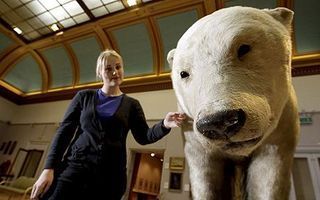The curator's egg
Museum and gallery curating seems just to have become sexy (again). That's partly thanks to the appearance of Hans-Ulrich Obrist's book, Ways of Curating (a riff on John Berger's Ways of Seeing, I assume). Obrist is co-director of the Serpentine Galleries and is interviewed here on curating history and ideology.
Quite why people like Obrist have to resort to Latin etymologies, heaven only knows. ("It comes from the Latin word curare, meaning to take care. In Roman times, it meant to take care of the bath houses" he says in the interview. What on earth does it have to do with "bath houses"??). But -- that apart -- I'm looking forward to getting my hands on the book, which (from what I'm told -- not seen it yet) explores all kinds of aspects of the art of gallery curation, and the different experimental forms it can take.
But it's just not Obrist. Curation seems to be the flavour of the month in Cambridge Museums too, with an on-going project on the "art and science of curation" -- including contributions from museum professionals and visitors too.
There's going to be a five week season of "curating events" later in the year. But there's a prequel already on this website. It hosts a variety of comments from members of the public on what they think "curating IS..." ("Curating is" ...."fun", "critical and controversial", "a vexed question" and so on. I particularly liked the one which said "How would you respond to the question, "Can I talk to your curator'?"). And there are also blogs from the curators themselves, including a nice mini-autobiography in curating by the new Director of the Fitzwilliam, Tim Knox.
It all took me back 20 odd years to 1991/92 and a little exhibition in the Ashmolean in Oxford that I co-organised with one of my colleagues, called the "Curator's Egg" (OK, feeble pun).
We were, I have to say, very lucky to be allowed to do this (neither of us could lay claim to any actual hands-on museum experience). The fact was that we had exploded at a seminar to Michael Vickers then curator of Greek and Roman at the museum -- about the conventions of curating, the silences of the display (why never say how much something cost?), the rebarbative conventions of the museum label (all those abbreviations that mean nothing to most visitors), and the blind eyes that curating tends to turn (when do we learn that most of the ancient artefacts of Greece and Rome on display were produced by slaves?).
Michael's response was brave." OK," he said, "if you think we have got it so wrong, then you can have one of our little exhibition spaces to show us how you think it should be done." We could hardly say no.
We crammed the little room in the Ashmolean with crazy labels and spoof information panels ("Please dont touch the ceiling", "SHHHHHHH!", "This is a product of slavery", "What aren't they showing you?" ... and a variety of price tags tied onto the objects). We piled up fragments of pottery in a big random heap, we treated a broken off statue head as if it really was a decapitation victim, and we introduced into the precious originals a plastic "garden-centre" Venus.
As museology, it was probably a bit mad (and there were rather too many juvenile jokes in a small space). But it did score a few good hits. One critic recently (and generously) wrote about how the show worked by "making visible questions of curatorial etiquette and decision making, challenging the devices that inscribe the visitor into the museum experience . . . and disturbing the prescribed routine of silent contemplation, non-tactile interaction and one-way routing." Which is exactly what we were trying to do!
I still have that plastic Venus in my college room -- and I have a feeling that Obrist himself might have quite liked the show.
Mary Beard's Blog
- Mary Beard's profile
- 4110 followers




